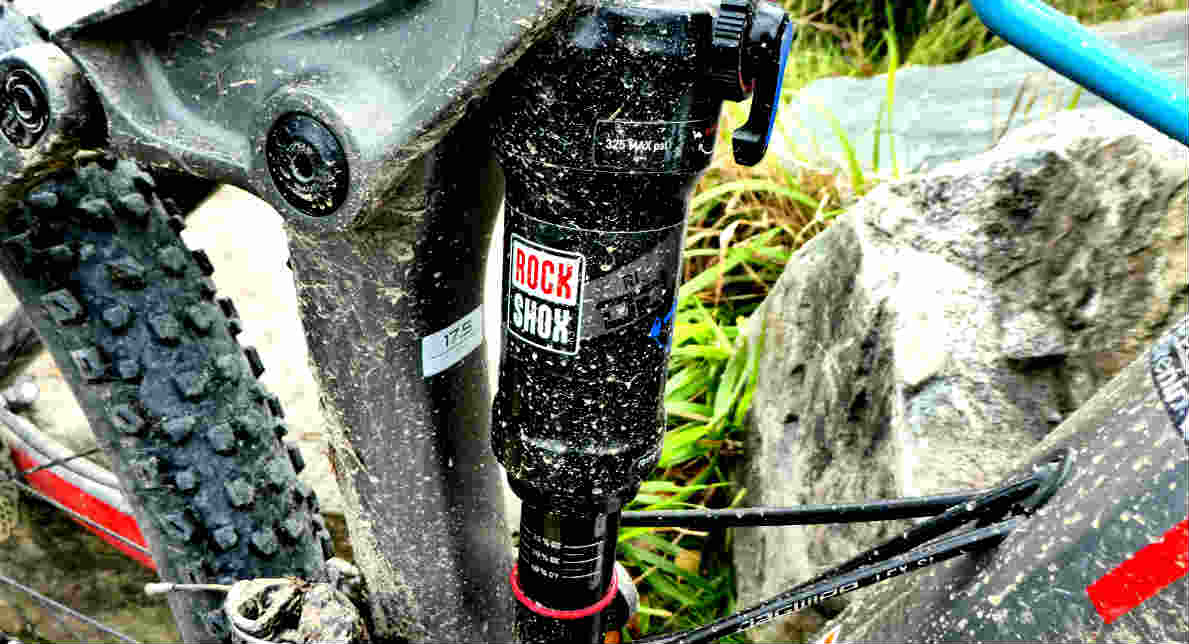Mountain Bike Suspension: The Essential Comprehensive Guide
Mountain bike suspension is what makes it possible for you to ride more technical terrain. How much mountain bike suspension you need, is all dependent on the type of riding you do, and the terrain you ride.
You may be unsure about what type of mountain bike to buy, if so, have a look at my guide to choosing a mountain bike. It is quite common for riders to buy “cheap” full suspension mountain bikes, when they would get a much better hardtail for the same price, that is more suited to them. Have a look at my post on how to choose between a hardtail and full suspension mountain bike.
The subject of mountain bike suspension is quite extensive. This is because manufacturers use different linkage systems for rear suspension. Mountain bike suspension forks vary a lot too, with regard to travel, shock absorbing ability and weight. This is my essential guide to mountain bike suspension.
Mountain Bike Suspension Forks
You get mountain bike suspension forks on both hardtail and full suspension mountain bikes. The suspension fork is a very important part of your bike. It determines how your bike performs, handles and rides. It is a good component to upgrade, (although an expensive one) to improve your bike.
Travel
As I mentioned before, the type of bike that you choose depends on the terrain you ride, and there is a different type of fork for each bike. They have different amounts of travel to suit different terrain. Typically, fork travel for each discipline is as follows:
- Cross country bikes – 80mm to 120mm
- Trail bikes – 120mm to 140mm
- Enduro bikes – 150 to 170 mm
- Downhill bikes – 180mm to 210mm
(although there are always exceptions)
So how much travel do you need?
In a nutshell, the more your suspension can move up and down, the more smoothly it can absorb the bumps. However, long travel forks are bigger and heavier. This is so they can cope with the forces from bigger impacts and the extra leverage.
If you fitted a new fork that was 10mm longer than your old one, the bikes geometry will change. The head and seat angles will be tipped back by about 1 degree. This will make your steering slower but more stable. Additionally, you may want to look at changing your handlebars and stem. You need to be careful when fitting a longer fork to your bike though. If you go too long, you can over stress your frame. You know those fail videos on YouTube, when the frame snaps? This is one of the reasons this happens. It will also void your warranty, so make sure you check the recommended maximum travel for your bike before buying. Therefore, you will probably only be able to have the same amount of travel when you upgrade.
How much do you spend?
Upgrading your mountain bike suspension fork, unfortunately is not a cheap thing to do properly. If you buy a cheap fork, you won’t get smooth shock absorption, damping, adjustability, quality and lightweight. This means your control won’t be as good when you are giving it the big ‘un and hitting larger bumps.
We refer to budget as below £400. Therefore, you need to make a descision, if it is worth upgrading your mountain bike suspension forks, with regard to the other components on your bike. It may be a case of saving up for a new bike, rather than putting expensive posh forks on an old bike.
For example, I knew someone who spent a lot of money upgrading a hardtail with new forks, brakes and handlebars to ride in the French alps. It still wasn’t suitable for the terrain, but if she sold the bike and used the money put aside for the upgrades, she could have bought a suitable used full suspension bike.
When upgrading your forks, you also need to be honest about your riding ability. This is because you can spend a lot of money on high end forks, that you may not get value for money from if you stick to riding mild terrain.
Adjustment
More travel means that your bike is harder to control. This is why it is essential to choose forks with adjustable damping, so you can make the fork return to its natural state smoothly. What you don’t want, is for it to return with a sharp clash. Higher end forks also have compression damping. This helps slow the down the spring to absorb the shock.
Forks at the very top end of the market have lots of adjustability. For example, some have split compression. This is where the damping is split in to two circuits. One circuit for low speed controlling loads, such as braking and turning and one for soaking up big impacts at high speed. I would only recommend you buy very high end forks if you know what you are doing, and if you have the time to tweak them properly.
If you just want to ride, with minimum faff, buy some simple and reliable forks. If you spend a lot of time cleaning, maintaining and learning about how your bike works, you may want something a bit more adjustable. But, if you want to geek out and like to fettle, I recommend that you buy forks with as much adjustment as possible.
=>Click here to learn about other mountain bike components<=
Strength
You need to consider how strong your new fork needs to be. This is because if you go for something really burly and you are not riding the terrain it is designed for, you are just hauling extra weight around the trails. This is actually quite hard to determine though, so you really have to go with manufacturer’s recommendations. But, lightweight forks are ideal for those that do a lot of climbing, while heavy ones are for more aggressive riding on rough terrain
Make sure it fits
You need to make sure that your new mountain bike suspension fork fits your bike before you buy. Most modern forks use tapered steerer tubes. These measure 1.5″ at the crown and 1.125″ at the stem.
There are also three different axles to consider:
- 9mm quick release is usually found on lower end forks
- 15mm through axles are found on lots of cross-country and trail bikes
- 20mm through axles are found on enduro and downhill bikes
=>Click here to learn how to look after your bike<=
Parts of Mountain Bike Suspension Forks
Crown
You will find that most mountain bike suspension forks are single crown. This is the bracing part that holds the legs together below the head tube of your bike’s frame. Mountain bike suspension forks with kits of travel are double crown forks, with a second brace at the top of the head tube. More crowns makes the forks stiffer, you can even find triple crown forks on some downhill bikes.
Steerer Tube
This is the top part of the fork that fits in to the head tube of your bike’s frame. Most of them steerer tubes are steel, but you can get mountain bike suspension forks with expensive carbon steerer tubes. Most are 1 1/8″ diameter, but you may find over sized tapered versions for extra stiffness. If your bike will take it, a tapered steerer tube is highly recommended.
Spring
Inside air mountain bike suspension forks, you have pressurized air chambers, known as air springs. These are light and easy to adjust to how you want them. But, their resistance increases has they reach their full compression. The alternative, is to use metal coil springs. These are heavier and not as adjustable, but they are cheaper and have a much smoother feel.
Legs
The legs are the moving parts of the fork and are joined together by at least one crown. The upper parts of the legs are called the stanchions and can have a diameter of up to 40mm. The bigger the diameter, the stiffer the forks are. They come with different external finishes, lengths and thicknesses. Each stanchion has its own job. The, left one usually hoses the spring, while the right hand one looks after the damping.
Damping
Damping prevents the fork from bouncing around on its springs. The movement is controlled by oil traveling through various valves and reservoirs in the fork. The level of damping is determined by how fast the oil moves from one side to the other. The characteristics of damping are as follows:
- Compression – This is controls the impact
- Rebound – This controls how the fork returns to its natural length
- High speed damping – This is what copes with the big hard hitting impacts from rocks and jumps
- Low speed damping – This controls the smaller forces that you get from cornering and bobbing around while pedaling
Cheaper forks only have rebound damping, while high end ones have separate damping circuits to handle different shaft and impact speeds.
Axle
It is very common now for mountain bike suspension forks to have 15mm or 20mm forks. This larger size makes the bottom end of the fork stiffer, which improves steering accuracy and they are a lot more secure than the old skewer type.
Mountain Bike Suspension – Rear Shock Overview
If you have a full suspension bike, the rear shock is critical for getting the most of your bike on technical and rough terrain. A rear shock is made up of two tubes that slide in to each other, a spring and an eye at each end to fix it to your bike. Each eye has a small bush to allow the shock to pivot smoothly as the suspension is working.
All mountain bike suspension rear shocks have a spring that compresses when you are riding over the rough stuff. They also have some kind of damping, unless you are looking at ones at the lower end of the market. This regulates how it compresses and rebounds. An undamped shock will rapidly go through its travel with a nasty clunk as it bottoms out. It will also spring around like a Pogo stick. If this is what you are experiencing, you may want to upgrade.
Mountain Bike Suspension – Choosing a Rear Shock
When considering upgrading your rear shock, your choice will be determined by two things:
- Size – The stroke and the eye to eye length of the shock. This is dependent on what your frame will take.
- Type – Air or coil
The size and type of shock are related and can depend on the type of riding your bike is made for. For example, cross-country riders will typically use short travel air shocks. While downhill riders may want long travel coil shocks.
Air or Coil shocks?
Coil shocks use a big metal spring. This is normally steel, but you can get titanium ones too. These are mounted on the outside of telescopic tubes that make up the body of the shock.
Air shocks use compressed air as a spring inside what is known as the “can”.
The type of riding you do will make a difference to which type of shock you choose, as will your budget. Generally, coil springs are cheaper, that is why you will find them on lower end bikes. Air shocks are lighter and a good thing to upgrade to, to reduce some weight. Air shocks are also very versatile in comparison to coil shocks. This is because adjusting an air shock to suit the rider’s weight, is just a case of increasing or decreasing the amount of air in it. Whereas to do the same, you may need to change the whole spring on a coil shock.
However, there are certain disciplines where a coil shock is preferable. If you ride downhill or free ride, weight is not really an issue. Therefore, you may want a high end coil shock. They have a more linear compression rate and can stiffen up towards the end of their travel. This is a great advantage for aggressive riders that reach the end of their travel often.
Coil shocks are better when the rider is going fast over rough terrain, with big drops. This is because it is smoother, more plush and tougher than a lightweight air shock.
Air shocks are becoming more rugged and reliable, which is closing the gap between the two types. However, there will always be a place for big burly coil shocks. Just look at the world cup downhill bikes.
Fitting a new shock
Before you fit a new shock, you need to be certain that it will fit your frame. Obviously, if you are just replacing the one you have with like for like model, it is just a straight swap. However, if you are upgrading, there are a few considerations to make sure your new one will fit.
The common misconception is that a shock’s size is its travel, this is not the case. The size of a shock is its stroke length and eye to eye measurement.
- Eye to eye measurement – The measurement between the center of the eyes at either end of the shock
- Stroke length – This is the amount the shock compresses when it is under full load. This is where people think that the shock’s travel is the stroke length. But, it all depends on the suspension design. For example, a stroke length of 50mm may be used on a bike with 100mm or 130mm of travel.
You also need to measure the connecting hardware. This includes the end bushings and the size of the bolts used to attach the shock. These are normally 5mm or 7mm.
Some frame designs don’t allow “piggyback” type shocks. These are high end air or coil shocks with an extra cylinder on the side, that holds extra oil for damping. This extra cylinder can hot the frame, so make sure your frame can take this before you buy one.
[table id=143 /]
Mountain Bike Suspension – Adjusting your rear shock
Preload and Compression Damping
The first thing to do is set your sag. This is the amount the shock compresses under the weight of rider when at a standstill. When setting your sag for the first time, set it up between 10% and 20%. Then you can tweak it after a couple of rides to make sure you are using all the travel available to you.
You adjust your sag on air springs, pumping it up or releasing air from it with a shock pump as necessary. A coil shock is usually adjusted by winding a knob to compress of release the spring. But, if you need to make big changes for a lighter or heavier rider, you will need to change the spring.
The rebound and compression of a shock, is controlled by oil flowing through valves inside. On higher end forks, you can adjust the rebound via dials on top of the cylinder.
Platform Damping
Platform damping only becomes active when a minimum threshold of force is exerted on the shock. The idea is to eliminate or reduce pedal bob. Pedal bob is the energy sapping movement of the bike bobbing up and down while you are pedaling. Lots of modern platform shocks offer a range of adjustment, from fully locked out to fully open. These give you options for adjusting the shock to suit the terrain you are riding.
Now you know
I hope this has been useful to you. As you can see, it is not a case of one type is better than another. The type of mountain bike suspension you use depends on your bike, your riding and the terrain you ride.
Don’t forget to sign up to the newsletter for loads more mountain bike information, updates and free ebooks.







